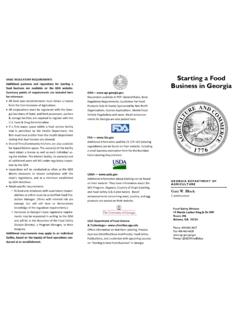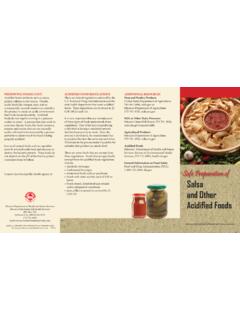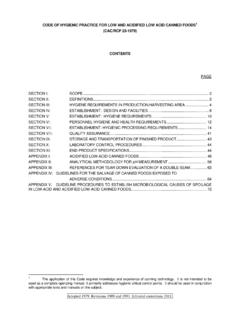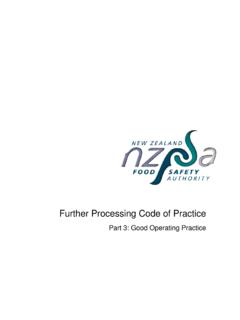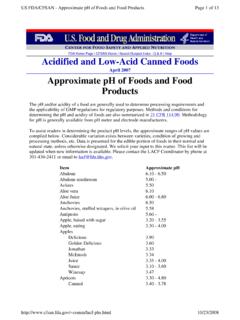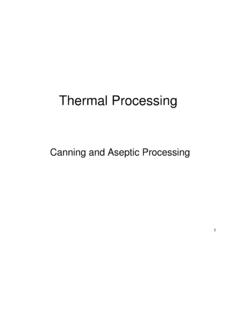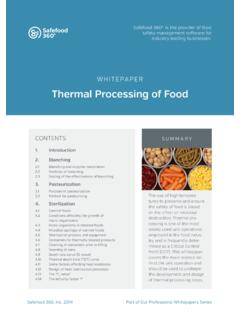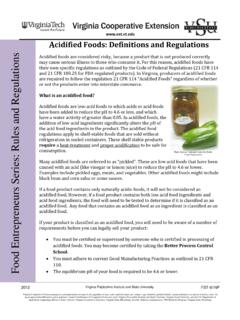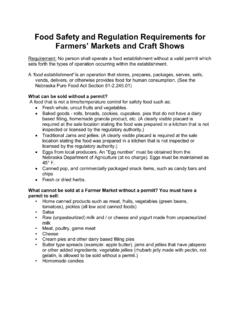Transcription of Guidelines for Food Processing Safety
1 Georgia Department of Agriculture 19 Martin Luther King Jr. Drive SW Atlanta, Georgia 30334-4201 Gary W. Black Commissioner EQUAL OPPORTUNITY EMPLOYER Guidelines FOR food Processing Safety There are Two Primary Categories of Processed Foods Regulated by the Georgia Department of Agriculture: Perishable: Refrigerated or frozen temperatures are required. Nonperishable: food items stored at ambient air temperatures above 41 F (shelf stable). PERISHABLE processed foods require refrigerated temperatures to insure food Safety ; less than 41 F for foods labeled Keep Refrigerated and foods maintained in frozen state for foods labeled as Keep Frozen . The low temperature slows or inhibits the growth of pathogenic bacteria making temperature controls and monitoring procedures very critical.
2 During Processing of perishable foods, exposure to temperatures above 41 F should be kept to a minimum. In all NONPERISHABLE (Shelf Stable Products), the target pathogenic bacteria is Clostridium botulinum. This organism s spores can withstand boiling temperatures for up to eight hours and reproduces by forming vegetative cells with spores. Spore destruction can only be accomplished by high heat (under pressure). An equilibrated pH of less than will prevent the germination of spores to vegetative cells. Equilibrium pH is usually recorded after holding the product for at least 24 hours. The greater the density of the product, the longer it takes to achieve equilibrium. The lower the pH at equilibrium, the greater the margin of Safety , but you must balance the Safety factor with palatability.
3 Growth of vegetative cells of C. botulinum can be prevented by: 1. Equilibrating the pH at or lower, 2. Keeping the water activity (Aw) at or below , or 3. Process for thermal destruction of spores. Nonperishable (or Shelf Stable) Processed Foods Can Be Further Classified into Three Categories: 1. acid FOODS are defined as foods that have a natural pH of or less. 2. ACIDIFIED FOODS (21 CFR ) are defined as a low acid food to which suitable acidifying agent including, but not limited to vinegar, citric acid , or natural acid foods, such as, tomato juice or lemon juice are added to adjust the pH to a safe level. An equilibrated pH of or lower is considered a safe level. A few examples of acidified foods are: relishes, fresh-packed pickles, chow-chow and salsa. 3. LOW- acid FOODS are defined as a low- acid food to which high temperature Processing is required to insure food Safety .
4 The low- acid food is containerized and heat treated under pressure for a specified period of time. This is commonly known as pressure cooking and involves products such as green beans, corn spinach, turnip greens, some vegetable soups, meats and fish. Equipment and Documentation Required Based on the Product Classifications: acid food Processing requires the following: 1. pH Meter 2. Processing record log (each lot) 3. Have process for all products reviewed by Processing Authority Acidified food Processing requires the following: 1. pH Meter Guidelines FOR food Processing Safety EFFECTIVE: 9/19/97 Page 2 of 3 REVISED: 7/16/15 2. Certified Thermometer 3. Processing record log (each lot) 4. Processed under the authority of an individual who has successfully completed the Better Process Control School.
5 5. Have schedule process for all products reviewed and approved by Processing Authority. 6. All schedule processes must be filed with FDA for interstate and intrastate commerce and the Georgia Department of Agriculture. All Low- acid food Processing * requires the following: 1. Retorts properly equipped as required by the Code of Federal Regulations. 2. Processing record log (each lot) 3. Processed under the authority of an individual who has successfully completed the Better Process Control School. 4. Thermometers (mercury in Glass) calibrated 5. Have a schedule process for all products established by a process authority, including heat transfer test for specific products, containers, retorts and sizes, and submitted to FDA. *Low- acid canned foods are seldom commercially processed on a small scale because of the expense involved in equipment and professional assistance as required by the Code of Federal Regulations 21 CFR 113.
6 All retorts must be approved through a Processing authority that conducts the heat transfer test specific for a single retort for each product, container size and type. Acidified & Low- acid Foods - Product Classifications and Scheduled Processes: Low- acid and acidified food processors fall under specific regulations, Low- acid Canned food (LACF) & Acidified Regulations 21 CFR 108, 113 & 114, requiring a classification and process approval of each product. Facilities that manufacture these products are required to have each product classified, and their process approved by a Processing Authority. The products that are classified as an Acidified food or Low- acid food are also required to register with the food and Drug Administration (form FDA 2541) and file a Schedule Process (form FDA 2541a, or for low- acid aseptic use form FDA 2541c)) with FDA.
7 FDA requires a separate process filing form for each acidified and low- acid canned food , each specific product formulation or style, and each container type or size. A firm must re-file a schedule process if any changes are made to the process, or if the firm relocates. For more information please visit the following FDA website regarding registration & process filing: Foods that are Exempt from the Requirements of 21 CFR 114 are: Carbonated Beverages Jams Jellies Preserves Fruit Spreads and Fruit Butters acid Foods1 Standardized and Non-Standardized food Dressings2 Condiment Sauces2 Fermented Foods Preserved by Microbial Fermentation, Such as Sauerkraut and Certain Pickles Alcoholic Beverages Foods with a Water Activity (Aw) of or Less Foods that are Stored, Distributed and Retailed Under Refrigeration1 Products with natural or normal pH of or below 2 Products that contain small amounts of low acid food (s) and have a resultant finished equilibrium pH that does not significantly differ from that of the predominant acid or acid food Guidelines FOR food Processing Safety EFFECTIVE: 9/19/97 Page 3 of 3 REVISED.
8 7/16/15 Brix of Jams, Jellies, Preserves and Fruit Spreads or Fruit Butters: JAMS, JELLIES OR PRESERVES: The Code of Federal Regulations (21 CFR ) require a Brix level of not less than 65% soluble solids. FRUIT BUTTERS: The Code of Federal Regulations (21 CFR ) require a Brix level of not less than 43% soluble solids. A routine sample of these products is to be submitted to the Georgia Department of Agriculture Lab to verify Brix. Product Labeling: Prior to the manufacture of products, all packaged product labels are subject to review by the Department as administrative procedures enjoin. Basic label requirement for food products include: 1. The NAME and ADDRESS including the Zip Code of manufacturer, packer or distributor. 2. The NET CONTENTS in definite units (Refer to ) a.
9 If liquid, in liquid measure b. If solid in terms of weight c. If a mixture (solid and Liquid) in terms of weight d. The declaration of contents of a package must be listed on the label and shall appear on the bottom 30 % of the principal display panel. 3. METRIC DECLARATION must be listed on label of food products. For example: Net oz (454 g.); Net. 16 Fl. Oz. (473 ml.) 4. The COMMON NAME of the product. 5. A LIST OF INGREDIENTS, in order of descending predominance by weight; with the sub-ingredients of each ingredient listed if applicable. 6. Under certain conditions, the following are necessary: A. OPTIONAL INGREDIENTS b. DIETARY PROPERTIES, if claimed c. If used, ARTIFICIAL INGREDIENTS must be so labeled d. PRESERVATIVES identified in the ingredients statement e.
10 Clearly indicated in the event anything is IMITATION f. NUTRITION FACTS PANEL, required by the Nutrition Labeling and Education Act (NLEA) g. ALLERGEN DECLARATIONS, either identified within, or listed immediately following, the ingredients statement 7. A PRODUCT CODE shall be applied to all packaged foods by the food manufacturer or processor at the time of packaging, which indicates information that would be useful in tracing the product back to the production date, location, and like information. Labels submitted for review by the Department should first be critiqued by the responsible Compliance or Processing Specialist and/or their Supervisor, with any deficiencies observed addressed with management and corrected prior to submission.
